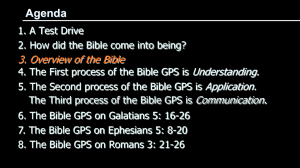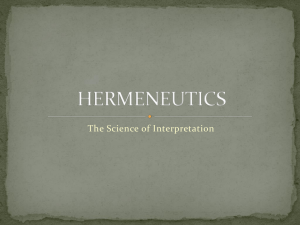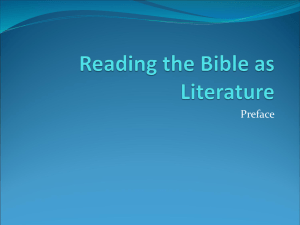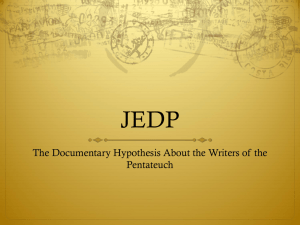Bible Manuscripts and Translations
advertisement
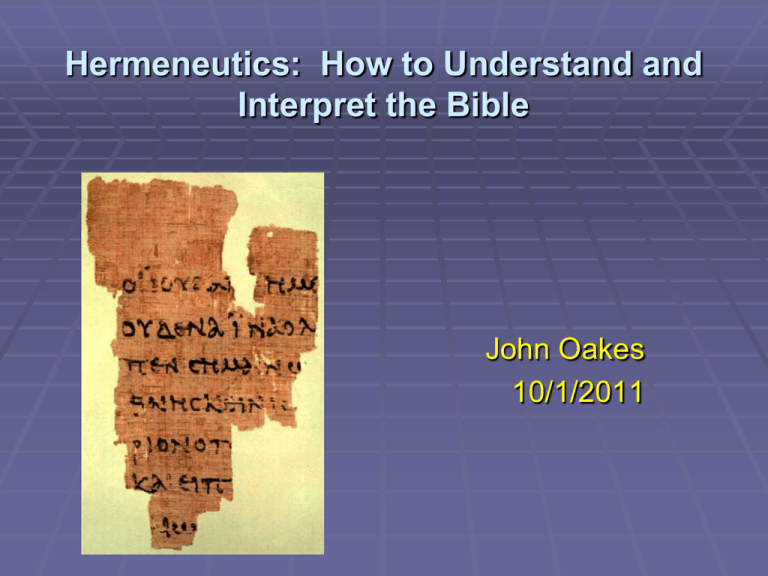
Hermeneutics: How to Understand and Interpret the Bible John Oakes 10/1/2011 Definitions Hermeneutics: The systematic study of the principles and methods of interpretation (of the Bible). The meaning in the greater sense.. Exegesis: Explaining the meaning of the text; i.e. what the author meant when he wrote to the people of his day. Homiletics: Practical application of the meaning of the text for us today. Eisegesis: Reading a meaning into the text which was not in the original (because of a bias of the interpreter) Exegesis → Hermeneutics → Homiletics The Problem of Misinterpretation Using the Bible to say something it does not say. Prov 29:18 KJV For lack of vision… Matthew 11:12 Matt 11:12 Using the Bible in an unbalanced way. faith/works righteousness/asceticism Confusing command and principle. 2 Cor 6:14 unequally yoked Is gambling wrong? 1 Cor 4:2, Rom 14:19-21 1 Cor 6:12 Why Good Hermeneutics? Get more out of your personal Bible study 1 Tim 4:13 Save yourself and your hearers Why Hermeneutics Works In the Bible, God speaks. 2 Peter 1:19-21, 2 Tim 3:16, 1 Thess 2:13. The Bible has been accurately transmitted and we have relatively good translations. The Bible is perfect—it is infallible. Ps 19:7, Ps 119:160. With work, the Bible is understandable. Deut 29:29 Why Hermeneutics Works (cont.) The Bible is complete. 2 Tim 3:17, Rev 22:18 God has chosen to use written words to communicate with his people. Verbal inspiration. Matthew 22:31-33. Argument from tense (Exodus 3:6). Gal 3:16 Argument from singular vs. plural. Matthew 5:17-18 Not a jot or a tittle will disappear. Hindrances to Good Hermeneutics Prejudice/Preconceived Ideas Pride Laziness Wishful Thinking Clergy/Laity Attitude Desire to Be Like (and liked by) the World Proof-text Approach Appeal to Authority Assuming what is popularly believed is true Lack of a plan Schismatic Attitude Helps to Good Interpretation The opposite of the preceding list. Common sense Sincere desire to know the truth Faith in God Education Good tools Tools Complete, exhaustive or analytical concordance. Bible dictionary. Topical Bible. Expository dictionary of NT words (Vine’s). Greek and/or Hebrew interlinear Bible. Greek and/or Hebrew lexicon. Commentaries: homiletic and analytic. History, and especially Church History books Other good translations. English Translations Word for Word Phrase for Phrase Thought for Thought (ie paraphrased) NASB New American Standard Bible (1971; update 1995) AMP Amplified Bible (1965) ESV English Standard Version (2001) RSV Revised Standard Version (1952) KJV King James Version (1611; significantly revised 1769) NKJV New King James Version (1982) HCSB Holman Christian Standard Version (2004) NRSV New Revised Standard Version (1989) NAB New American Bible (Catholic, 1970, 1986 (NT), 1991 (Psalms) NJB New Jerusalem Bible (Catholic, 1986; revision of 1966 Jerusalem Bible) NIV New International Version (1984) TNIV Today’s New International Version (NT 2001, OT 2005) NCV New Century Version NLT1 New Living Translation (1st ed. 1996; 2nd ed. 2004) NIrV New International reader’s Version GNT Good News Translation (also Good News Bible) CEV Contemporary English Version Living Living Bible (1950). Paraphrase by Ken Taylor. Liberal treatment of ‘blood.’ Message The Message by Eugene Peterson (1991-2000s) Version Type # Translators NASB word for word 54 AMP word for word 13 ESV word for word 100+ KJV word for word 54 NKJV word for word 119 HCSB word for word/phrase for phrase 90 NRSV word for word/phrase for phrase 30 NAB word for word 55 NJB phrase for phrase 36 NIV phrase for phrase 115 TNIV phrase for phrase 115 NLT phrase for phrase 90 CEV paraphrase 100+ NIrV paraphrase 11 GNT paraphrase 7 Message paraphrase 1 Which is the Best Translation? It Depends... Probably more than one. What is the goal? To do a deep and detailed study in order to do Bible teaching or to deepen our own personal knowledge of the scripture. Reading the scripture to allow an entire section have an impact. Reading scripture in public (what public?) Studying out, defending and explaining a doctrine. Reading for inspiration and to give personal faith. Doing a word study, Doing a topical study, etc…. We are not limited to English translations Greek Interlinear Greek Lexicon Comprehensive Concordance Commentaries Should We Stick to the NIV? What About the KJV “Authorized” Version? Critics of the NIV (and other translations) say: In every case, when the KJV is compared with the NIV, the KJV is better. The KJV contains the whole Bible and has no deletions. Revelation 22:18 The KJV is more hard hitting and does not compromise with the world. The KJV uses better Greek and Hebrew manuscripts: The Textus Receptus. The translators of the NIV were homosexuals and/or deists who reject the deity of Jesus Christ. Authorized Version KJV Is Always More Accurate Examples: Holy Ghost James 3:13 Proverbs 18:24 Romans 3:25 This is a biased analysis which no serious scholar would support. KJV uses archaic words, poorer manuscripts, word meanings have changed….. KJV (Unlike The Others) Has No Deletions Revelation 22:18 Matthew 5:18 Acts 8:37, 1 John 5:7-8, Luke 17:36, etc. Which is worse, additions or deletions? AV Uses Superior Greek Manuscripts Textus Receptus (Erasmus, 16th century) Byzantine Text Family Alexandrine Text Family Western Text Family Telephone… Hebrew Text and Scholarship Problems Conclusion The debate over the “right” English translation is not a useful one. A student of the scriptures who does not have a deep knowledge of the original languages will use more than one translation, as well as other resources to arrive at a good understanding of the meaning of the text. Arguments that the King James Version is the only acceptable, inspired translation and that others are demonic are biased, full of logical fallacies and simply not valid. A Brief History of Hermeneutical Styles Jewish Approaches Allegorical Interpretation: Alexandria Historical/Grammatical: Antioch Mystical: Gnostics Authoritative: Rome Dogmatic: JWs Literalism: Premillenialism Inductive/Analytical: Alexander Campbell and CoC Command, Example, Necessary Demonstration. Speak where the Bible speaks, be silent where the Bible is silent ICOC Where the Bible speaks we are silent, where it is silent we speak A Better Approach? William of Ockham: What is true? What is known per se, evident from experience or proved by authority of scripture. Revelation, Deduction, Induction Revelation: Direct Command Deduction: Principle Induction: Wisdom, Experience Assignment 1. Pray about the hindrances to good Bible interpretation. Make it personal. 2. For the book of Galatians; Read it. Find a theme verse. Discover an overall theme for the book. Create an outline for the book. Use a Bible dictionary or commentary or other resource to determine the historical and cultural context of the writing of the book. 3. Come up with a single scripture, a section of a book or an entire (small) book you want to analyze using the principles of hermeneutics. Rules/Guidelines of Hermeneutics 1. Every passage has one meaning. 2. The most obvious meaning is usually the correct one. 3. Always allow the author’s explanation to stand. 4. Always interpret a passage within the context of the passage, the book, and the situation. 5. An interpretation of a passage should conform to the environment of the author. 6. Rightly divide books by dispensation, covenant and setting. 7. Interpret every passage in the light of all others. 8. One passage will often explain another. Rules/Guidelines (cont.) 9. Let plain passages interpret difficult ones. 10. All passages on a subject must be studied before a conclusion is drawn. 11. Observe the proper balance of scriptural truth. 12. Passages should be interpreted in harmony with the idioms contained. 13. Rightly divide the language (grammar and figures of speech). 14. Correctly distinguish the figurative from the literal. 15. Know the meaning of sentences, phrases and words. 16. Rightly divide books by type of literature (poetry, apocalyptic, historical, doctrinal, etc.). 1. Every Passage Has One Meaning Our job is to discover that meaning. What is the meaning of Ps 16:8-10? Use Acts 2:25-27 2 Cor 6:14? 2. The most obvious meaning is usually the correct one. John 3:3-8 What does “born of water and the spirit mean? Eph 4:5,6 What is the “one baptism”? 3. Always Allow the Author’s Explanation to Stand 1 John 3:6 No one in Christ continues to sin. Daniel 11: vs. 2-4 The kings of the North and the South are Greek kings. Jn 2:19-21 What is Jesus talking about? Psalm 82:5-8 What does “gods” mean? 2 Tim 3:17 2 Tim 2:13 Author’s Explanation… Look for the explanation in the 1. immediate context 2. that “chapter” 3. that book 4. that author 5. the whole Bible. 4. Always interpret a passage within the context of the immediate passage, the book and the situation Context, Context, Context….. John 9:31 Matthew 18:20 Revelation 3:20 Matt 12:30 vs Mark 9:40 1 Cor 11:2f vs 1 Cor 14:33-35 It shall greatly help thee to understand Scripture, If thou mark not only what is spoken or written, But of whom, And to whom, With what words, At what time, Where, With what circumstances, Considering what goeth before And what followeth. 5. The interpretation should conform to the environment of the author 1 Tim 2:8-15 1 Tim 3 vs Titus 1 Qualities of Elders Mark 10:23 1 Cor 8:4 6. Rightly divide by dispensation, covenant and setting Patriarchal First Covenant The Second Covenant The thief on the cross Acts 15:24-29 Two covenants meet. Romans 9:13-21 Predestination? Be aware of progressive revelation. 7. Interpret every passage in light of all others Acts 2:21 explained by Rom 10:9, 2 Tim 2:19 8. One passage will often explain another 1 Thess 4:15-17 Is there room for a rapture here? 2 Pet 3:11-13 Harmonize Prov 26:4 and Prov 26:5 Harmonize Ex 20:5-6 with Ezek 18:20 Harmonize Prov 13:25 with Psalm 73:1-5 9. Let plain passages interpret difficult ones. 1 Cor 15:29 Q: What does it not mean? Romans 8:28-30 Does this justify a strict predestination? See Hebrews 6:4-6, 10:19-32 Ezekiel 18:25-29 Rev 20:13,14 10. All passages on a topic should be studied before a conclusion is reached. Jn 14:14 James 4:2,3 5:13-16 1 John 5:14,15 (on prayer) Use John 3:16 for salvation? Rom 10:9 Is confession with your mouth sufficient, alone, for salvation? (it is with your mouth that you confess and are saved) Consider 2 Tim 2:19 11. Observe the proper balance of biblical truth Eph 2:8-10 vs James 2:24 (faith and works) Phil 2:12 and 2 Cor 13:5 vs 1 Jn 5:13 Romans 8:37 and Hebrews 10:19 (assuring vs. assured) Predestination vs Free Will Romans 9:19-21, Romans 8:29 vs. Deut 30:19,20 12. Passages should be interpreted in light of idioms contained in them. Like a camel through the eye of a needle. Mark 10:25 Luke 22:31 Satan wants to sift you like wheat (Could 1 Cor 11:13 “with her head uncovered” be an idiom?) 13. Rightly Divide the Language (grammar, figures of speech) Anthropomorphisms Psalm 44:3 Personification Psalm 114:3 Hyperbole Psalm 51:5 Matthew 9:47 Psalm 22:6 Irony, sarcasm Galatians 5:12 Simile Matthew 3:16 Isaiah 53:6 Metaphor Matt 26:26 Luke 13:32 Allegory Ephesians 6:11-17 Metonymy 1 Cor 11:25 Synecdoche Deut 8:3 Grammar 1 Cor 11:27 Unworthy or unworthily? Matthew 16:18 masculine vs feminine 14. Correctly Distinguish the Figurative from the Literal How do we know a passage is figurative? An implied absurdity Luke 9:60 Mal 1:2-3 When literal interpretation implies a contradiction or inconsistency. John 11:25-26 When it requires a clearly immoral conclusion Matt 18:9 When the context implies it or the author says so. Jn 2:18-20 Common sense. John 4:10-15 Apocalyptic literature works very differently 15. Know the meaning of words, phrases and sentences. Websters vs Greek vs Biblical definition. Church Flesh Soul Bread Spirit In interpreting passages, look for key words and define them carefully 1 Cor 11:2-16 head (v. 3) authority (v. 10) Rom 8:5-11 16. Rightly divide books by type of literature. Poetry Loaded with metaphor, hyperbole, etc. Look for the feeling, not the doctrine. Ps 51:5 Proverb Principle, not promise or command. Prov 13:24, Prov 22:6 Historical Look for the practical application Acts 6:3 Doctrinal Can be most carefully analyzed Apocalyptic Assume figurative unless the context demands literal Type/Antitype Type/Antitype Interpretation 1. If a NT writer says a particular passage in the Old Testament is a foreshadow/prophecy/prefigure/type, then it is. Jn 3:14 2. If an Old Testament passage works as a foreshadow/prophecy/prefigure/type both in the general sense and in the specifics, then it is probably legitimate. 3. If one already knows that a general event in the Old Testament is a foreshadow/prophecy/prefigure/type, then it is safer to assume that the details are foreshadows as well. Gen 22:1-11.



